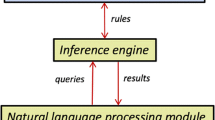Abstract
This paper discusses some engineering considerations that should be taken into account when building a knowledge based system, and recommends isomorphism, the well defined correspondence of the knowledge base to the source texts, as a basic principle of system construction in the legal domain. Isomorphism, as it has been used in the field of legal knowledge based systems, is characterised and the benefits which stem from its use are described. Some objections to and limitations of the approach are discussed. The paper concludes with a case study giving a detailed example of the use of the isomorphic approach in a particular application.
Similar content being viewed by others
References
Allen, L. E. & Saxon C. S. 1991. More IA Needed in AI: Interpretation Assistance for Coping with the Problem of Multiple Structural Intepretations. In Proceedings of The Third International Conference on AI and Law, 53–61. Oxford:ACM Press.
Bench-Capon, T.J.M., Robinson, G. O. Routen, T. W. & Sergot, M. J. 1987. Logic Programming for Large Scale Applications in Law: A Formalisation of Supplementary Benefit Legislation. In Proceedings of The First International Conference on AI and Law, 190–198. Boston:ACM Press.
Bench-Capon, T. J. M. 1989. Deep Models, Normative Reasoning and Legal Expert Systems. In Proceedings of The Second International Conference on AI and Law, 37–45. Vancouver:ACM Press.
Bench-Capon, T. J. M & Forder, J. M. 1991. Knowledge Representation for Legal Applications. In Knowledge Based Systems and Legal Applications, ed., T. J. M. Bench-Capon, 245–264. Academic Press.
Bench-Capon, T. J. M. & Coenen, F. P. 1991. Practical Application of KBS to Law: The Crucial Role of Maintenance. In Legal Knowledge Based Systems, Aims for Research and Development, eds., C. van Noortwyk, A. H. J. Schmidt, R. G. F. Winkels, 5–17. Lelystad, The Netherlands: Koninklijke Vemande BV.
Bench-Capon, T. J. M. & Coenen F. 1991. Exploiting Isomorphism: Development of a KBS to Support British Coal Insurance Claims. In Proceedings of The Third International Conference on AI and Law, 62–68. Oxford:ACM Press.
Bench-Capon, T. J. M. 1991. KBS Applied to Law: A Framework for Discussion. In Bench-Capon T. J. M. (ed), Knowledge Based Systems and Legal Applications, ed. T. J. M. Bench-Capon, 329–342. Academic Press.
Bench-Capon, T. J. M., Coenen, F. P. & Dunne, P. E. S. Integrating Legal Support Systems Through Document Models. Expert Systems with Applications (to appear).
Bratley, P., Fremont, J., Mackaay, E. & Poulin, D. 1991. Coping with Change. In Proceedings of The Third International Conference on AI and Law, 69–76. Oxford:ACM Press.
Bratley, P., Poulin, D. & Savoy, J. 1991. The Effect of Change on Legal Applications. In Proceedings of DEXA Berlin, ed. D. Karagiannis, 436–441.
Coenen, F. & Bench-Capon, T. 1991. A Graphical Interactive Tool for KBS Maintenance. In Proceedings of DEXA Berlin, ed. D. Karagiannis, 166–171.
Glickfield, Barnett W. 1991. Perpetuities Reasoning Captured and Automated in a Logic Program. In Proceedings of The Third International Conference on AI and Law, 128–136. Oxford:ACM Press.
Gray, J. 1986. The Rule Against Perpetuities. Boston: Little, Brown and Company.
Jackson, M.A. 1975. Principles of Program Design. Academic Press.
Johnson, P. & Mead, D. 1991. Legislative Knowledge Based Systems for Public Administration — Some Practical Issues. In Proceedings of The Third International Conference on AI and Law, 108–117. Oxford: ACM Press.
Karpf, Jorgen. 1989. Quality Assurance of Legal Expert Systems. Jurimatics No 8, Copenhagen Business School.
Kowalski, R. A. 1989. The Treatment of Negation in Logic Programs Representing Legislation. In Proceedings of The Second International Conference on AI and Law, 11–15. Vancouver:ACM Press.
Routen, Tom 1989. Hierarchically Organised Formalisations. In Proceedings of The Second International Conference on AI and Law, 242–250. Vancouver:ACM Press.
Routen T. W. & Bench-Capon, T. J. M. 1991. Hierarchical Formalisations. International Journal of Man Machine Studies 1:69–93.
Sergot, M. J., Sadri, F., Kowalski, R. A., Kriwaczek, F., Hammond, P. & Cory, H. T. 1986. The British Nationality Act as a Logic Program. Communications of the ACM 29:5 370–386
Sergot, M. J. 1991. The representation of Law in Computer Programs. In Knowledge Based Systems and Legal Applications, ed. T. J. M. Bench-Capon, 3–68. Academic Press.
Sergot, M. J. Kamble, A. S. & Bajaj, K. K. 1991. Indian Civil Service Pension Rules: A Case Study in Applying Logic Programming to Regulations. In Proceedings of The Third International Conference on AI and Law, 118–127. Oxford:ACM Press.
Storrs, G. E. & Burton, C. P. 1989. KANT, A Knowledge Analysis Tool. ICL Technical Journal 6:572–581.
de Vey Mestdagh, C. N. J. 1990. How Artificial Should Artificial Intelligence Be? In Legal Knowledge Based Systems: An Overview of Criteria for Validation and Practical Use, eds. Kracht D., de Vey Mestdagh, C. N. J. and Svensson, J. S. 93–104. Lelystad, The Netherlands:Koninklijke Vermade.
Author information
Authors and Affiliations
Rights and permissions
About this article
Cite this article
Bench-Capon, T.J.M., Coenen, F.P. Isomorphism and legal knowledge based systems. Artif Intell Law 1, 65–86 (1992). https://doi.org/10.1007/BF00118479
Received:
Accepted:
Issue Date:
DOI: https://doi.org/10.1007/BF00118479




